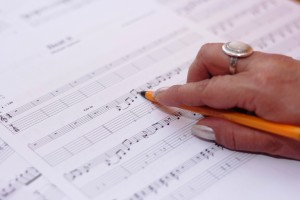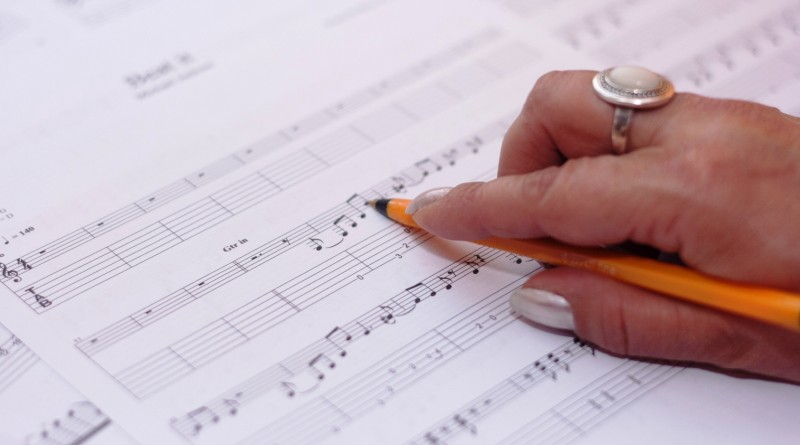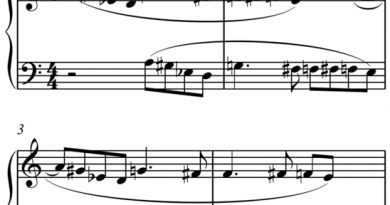Jazz melody composing : chordal, turning, passing notes
This is the most important chapter! In this page I explain how you can build a melody : these “rules” are not only for improvisation but for composing songs and other instrumental or vocal pieces.
I suggest you to learn every item to build melodic lines; they base on classic and jazz harmony and you can improvise or compose easily and correctly by knowing them. I want to specify that knowing and mastering harmonic techniques are not enough to create high artistic value music. Musician has to express emotions, ideas and messages to himself and to the public, besides playing in a right harmonic way.
So an improviser needs:
- Well trained hands
- Learned mind
- Open hearth

When these three faculties are synchronized and in harmony, your improvisations, compositions and your music become magic and have a great emotional power.
Melody is the most powerful and beautiful item of music. It has symmetric, geometric and harmonic rules:
Pay Attention: I mean 1th , 3th, 5th and seventh ( of a chord ) by “Chordal note”
When you improvise or compose, you can use to build a melody these notes: generally they are chordal notes or notes that return on them. So the fundamental melodic concept is:
Melody is based on the Chord and on the Key in which it is. Here are the most used and important e rules or suggestions to build a melody.
- Chordal notes
- Turning note
- Passing
- Leaning
- Delaying
- Anticipated
- Chromatic
- Mixe
- Double leaning tones
Test every item with your ears! Let me know what you think about!
1. Notes of the chord – (Chordal notes)
( = chordal note)
In this video I improvise on a minor seventh chord using only chordal notes
playing just eight notes
Also in this other video I use only chord’s notes

- You can use the notes of a chord freely
2. Turning note : does not belong to chord but comes from a note of the chord and turn on it. ( T = Turning note)
Watch this sample video on turning notes

- You have to turn on the note of the chord
3. Passing note : it is between two chordal notes. ( P = Passing note)
Sample piano video on passing notes for the melody building

How to build a jazz melody in improvisation : leaning, delaying, anticipated notes
4. Leaning note (Appoggiatura) : it leans on a chordal note ( L = Leaning note)
Here is a piano video about leaning and chromatic notes

- After a leaning note you have to play the chordal note close to it
5. Delaying note (Ritardo) : it delays a chordal note ( D = Delaying note)

After a delaying note you have to play the straight away below chordal note
The difference between leaning and delaying note is: the first one can go up or down to a chordal note while the second must go down to the straight away below chordal note!
6. Anticipated note (Anticipo) : it belongs to the next chord ( A = Anticipated note)

Jazz melody composing : chromatic, mixed, double leaning notes
7. Chromatic note : it belongs neither chord nor key ( C = Chromatic note)

I distinguish these cases:
7.1 Chromatic passing note ( Cp)
7.2 Chrom. turning note ( Ct )
7.3 Chromatic leaning note (Cl )
8. Mixed notes : they are a mix or a combination of previous cases:

For example:
- Passing note of a passing note (also chromatic ) =Pp
- Pass. note of a turning note (also ch. ) =Ptu
- Turning note of a turning n. (also chrom. ) =Tt
- Passing note of a delaying note (also chr.) =Pd
- And so on…
9. Double leaning tone ( =Ld ). This is a beautiful melodic embellishment and you can play it both in downbeat both upbeat
Live piano video to understand what is a double leaning tone

This is a good melodic ornament
Melodic concepts and how to compose a melody
Finally, melodic concepts are very simple:
- every dissonance or tension must be solved
- melody must have an harmonic, regular development
- You have to vary phrasing
- Melody is an harmonic balance between tension and rest





Been enjoying jazz for quite some times now.